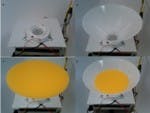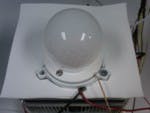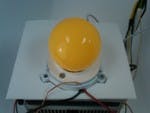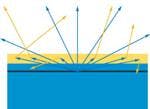This article was published in the July/August 2012 issue of LEDs Magazine.
View the Table of Contents and download the PDF file of the complete July/August 2012 issue, or view the E-zine version in your browser.
+++++
While there are no true white LEDs, there are numerous approaches to generating white light with LEDs. The most common solid-state lighting (SSL) luminaire and lamp designs today use white LEDs that have a phosphor applied directly in the package with a blue emitter to produce white light – phosphor-converted LEDs. Another approach called remote phosphor relies on blue LEDs, a mixing chamber, and phosphor-coated secondary optics that are physically separated from the LED source. There are proponents of both approaches, although of late the remote-phosphor side has claimed an efficacy advantage as high as 30%. In this article we will evaluate the two approaches in specific downlight and omnidirectional retrofit lamp applications to understand the tradeoffs in terms of cost, performance, and other factors.
A fair comparison first requires the same baseline LED technology with matching performance for use in both approaches. Cree builds white LEDs and royal blue LEDs in the XLamp XT-E family using the same manufacturing platform with matching wavelength and radiant flux power. The wafers that will become white LEDs are coated with phosphor while those destined to be blue LEDs are left bare. The LEDs are packaged identically in the 3.45×3.45-mm XT-E form factor. The application engineering team at the Cree Santa Barbara Technology Center (SBTC) assembled the blue and white LEDs into separate modular light engines based on a 9×9 array of LEDs.
A fair comparison also should include evaluation of the two approaches in typical operating conditions.The evaluation included 25°C baseline testing as well as high-flux and high-temperature testing. For at-temperature evaluation of the different configurations, the team mounted the light engine on a heat stage at 85°C and waited 30 minutes for the module to reach a steady state condition. During the actual tests, the LEDs were driven at 700 mA giving a system level light output of about 1400 lm.
Downlight and lamp configurations
Having defined the conditions for the testing, let’s move on to the specifics of the downlight and lamp configurations. The team built a 4-in white LED downlight using a light engine with white LEDs, a plastic reflective cone, and a 4-in polycarbonate diffuser (Fig. 1). For the remote phosphor version, the team used a royal-blue light engine, a white plastic reflective cone, and the large and small phosphor-coated discs discussed previously (Fig. 2). In each of the figures you can see the two light engines mounted on the aforementioned heat stage.
Tabulated measurements
Now let's consider the data gathered during the actual test starting with the downlight. The team took flux measurements in a variety of conditions, summarized in Table 1 for the downlight comparison.
The baseline light output from the bare white LEDs at 85°C steady state condition was 1234 lm. In order to compare the white LEDs fairly with the remote phosphor system, the team measured the white LED flux in a white reflector and then with the diffuser disc to simulate the typical downlight application scenario. The application-level measured flux was 1146 lm, and that is the value used as the baseline for comparison with the remote phosphor system.
Now let’s consider the test of the retrofit lamps (Table 2). The baseline light output from the bare white LEDs is 1234 lm, the same as the downlight baseline. The light output for the white LEDs with diffuser bulb added is 1099 lm at the 85°C steady-state temperature. The tested optic had a light diffuser coating, typical of retrofit lamps although some products might feature higher diffuser loading which would result in a lower light output. The 1099-lm figure served as the baseline for comparing the remote phosphor system.
Thermal color stability
The application team also measured color shift of the tested lights from the chromaticity at 25°C to that at 85°C. We won’t detail those results here, although they will be available at a later time on the Cree website. But we will summarize the results.
Of course the lamp or luminaire design team can easily accommodate color shift by testing products at temperature. Moreover LED component vendors such as Cree are increasingly binning components at 85°C so the product designer can be assured how the components will perform in application.
How it works
In an integrated white LED, the phosphor is very close to the chip, either as a thin coating or embedded in a silicone encapsulant matrix. The blue light generated by the LED chip emits in all directions. Some of the light rays will interact with the phosphor on the LED chip resulting in a conversion into yellow light. Actually the converted light consists of many different wavelengths, but the spectral distribution is primarily yellow. These yellow rays are also emitted in all directions and some of them will reflect back to the LED chip and be absorbed, resulting in an efficiency loss (Fig. 5).
In comparison, in a remote phosphor system, the phosphor is placed far from the LED chip. As the blue light reaches the phosphor and excitation-emission process occurs, the yellow light from the phosphor emits in all direction as in the white LED, but since the LED chip is far away, the chances of these yellow rays hitting the chip and being absorbed is significantly lowered. As long as the remote phosphor system is well designed with a high-efficiency reflector that redirects yellow light reflected downward, the overall efficiency in a remote phosphor system will be higher than in the case of the white LED.
Cost tradeoffs
So finally we come to a rough cost comparison of our approaches. You can always add LEDs to make a light engine brighter. And you must account for the entire system cost of each approach.
Lighting system designers and integrators must decide which approach best fits their application. The remote-phosphor approach does offer the advantage of color stability. Conversely in some applications, lighting designers or end customers prefer a white look as opposed to the yellow tint of remote phosphor optics when the lamp or luminaire is off.
Our comparison shows that remote-phosphor systems can provide light output gain of 20% in a high flux, high temperature environment. For now those gains come with an increase in system cost and potentially patent-licensing fees. Product designers must determine if one or the other approach is best for their specific application. But until the cost of remote phosphor comes down, white LEDs will likely be the dominant choice for general lighting applications.













